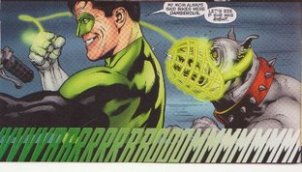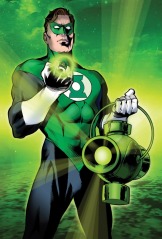
The Green Lantern’s ring is considered most powerful weapon in the world (in the world that makes up the DC Universe, that is; Marvel fans, you’ll always have the Ultimate Nullifier, as brandished by Reed Richards, a.k.a. super-genius super-elastic Mr. Fantastic, below).

“Galactus, shmalactus!”
The origins of the Green Lantern’s power comes from some giant green bug zapper on the alien planet Oa, but it’s widely recognized that the true power source is a mix of courage and creativity possessed by the ring-bearer.
Courageous heroes have been a dime a dozen since the Golden Age of comics (with inflation for today’s era, that’s more like $3.99 and a free digital download a dozen).
I’ve got nothing against courage, but to me what makes a Green Lantern special is that his (or her) powers are limited only by the ring-bearer’s creativity and imagination.



“Imagination is more important than knowledge.”
Albert Einstein said that, and he’s probably the closest thing to a super-genius we’ll ever have in our real world. (At the least, he looks the part.)

We may not ever teach the next Albert Einstein, but we can help each individual practice and expand his and her creative energies. All of our students have creative potential. (And for anyone who thinks otherwise, just take a quick look at the stall graffiti in a boys’ restroom.)
I would imagine that all of us teachers want to encourage creativity in our students. Such ingenuity is welcomed in our current world exploding with “user-generated” content. However, a 2012 survey found that a majority of Americans (82%) felt that “as a country, we are not living up to our creative potential.” A lesser number (but still a majority—62%) of Americans felt that our educational system stifles creativity.
Granted, this survey was published in a report by Adobe to coincide with the launch of its new Creative Suite 6 software, so maybe there’s a little extra motivation to push creativity. Software purchases and preferences aside, I’m sure most of us would agree a little more creativity is a good thing in our schools and society.
So how do we foster creativity in our schools?
When I was a new science teacher, I struggled to overcome a reliance on bland vocabulary memorization and plug-and-chug calculations for finding velocity, genotype probabilities, limiting reagents, etc. Science has always suffered from the misconception that scientific work is “uncreative.” This myth has festered in part due to a litany of “cookbook” lab activities that instill tedious conformity and an emphasis on a singular, step-by-step “scientific method” (McComas, 1996).
Nevertheless, I soon found that there are all sorts of ways to teach and encourage student creativity in the science classroom. Even if you don’t teach science (Reed Richards and I forgive you), consider how you can use some of the following ideas from Clark, Clough, and Berg (2000, p. 42) to mentally engage students in creative thinking in your own subject discipline. (Here’s a hint: replace “lab” with “activity” or “project,” and remember “data” = “information”):
- Consider including students in determining the lab question to be investigated.
- Encourage students to invent laboratory procedures (consider safety, equipment, and cognitive issues).
- Structure the experience so students are mentally engaged in the lab, even if they cannot invent laboratory procedures.
- Encourage students to consider and defend what data is relevant and irrelevant.
- Have students decide what their data mean.
- Require students to apply mathematical reasoning to problems.
- Make students responsible for clearly communicating their lab work in a clear manner (creating their own data tables, organizing and presenting information, etc.).
- Have students set goals, make decisions, and assess their own progress.
- Ask questions that spark ideas and reduce student frustration.
- Refrain from summative evaluations of students’ ideas and interpretations.
Chances are you won’t be able to make each of these changes to every lesson. But you can assuredly make a few tweaks and adjustments to an activity here, an assignment there, and gradually transform your classroom into a place that cultivates and champions creativity.
Does this transformation sound daunting? Scary?

If you need some extra courage, just grab a green ring and recite the following oath:
In brightest day, in blackest night,
No evil doldrums shall escape my sight.
Let those who worship evil’s humdrum’s might,
Beware my power, Green Lantern’s CREATIVE light!!!
So is creativity the most powerful weapon in the universe? Perhaps. Or maybe it’s something different.
In honor of Nelson Mandela’s recent passing, consider his words:
“Education is the most powerful weapon which you can use to change the world.”
Now there’s a hero.

Recommended Reading:
Clark, R., Clough, M., & Berg, C. (2000). Modifying cookbook labs. The Science Teacher, 67 (7), 40-43. Available at http://www.nsta.org/publications/news/story.aspx?id=45060.
McComas, W.R. (1996). Ten myths of science: Reexamining what we think we know about the nature of science. School Science and Mathematics, 96(1), 10-16. Available at http://onlinelibrary.wiley.com/doi/10.1111/j.1949-8594.1996.tb10205.x/abstract.









